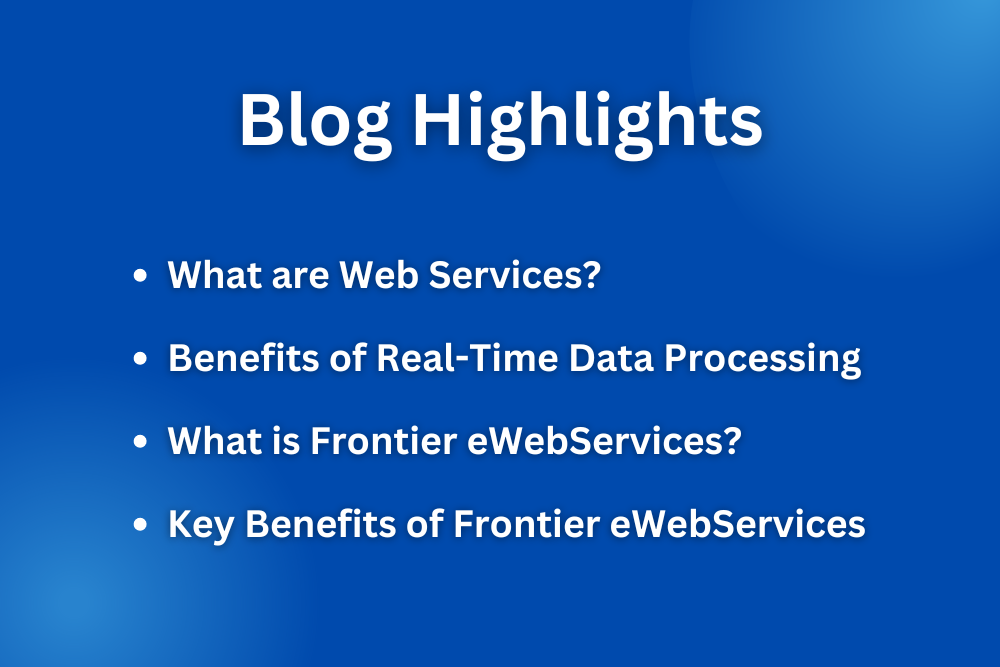
Imagine simplifying the entire process of quoting and ordering, all while ensuring your data is always up-to-date. With web services, you can turn this into a reality. By leveraging real-time data processing, you can streamline communication, minimize errors, and enhance customer satisfaction.
Whether it’s generating quotes or managing orders, Frontier eWebServices provides the tools you need for seamless integration. Let’s dive into how this powerful solution can transform the way you do business.
What are Web Services?
Before we explore how Frontier eWebServices can help your company, let’s take a behind-the-scenes look at web services.
Web services are standardized ways of enabling communication and data exchange between different software applications over a network, typically the Internet. They allow systems to interact with each other using standard protocols and formats, regardless of technology or platform.
Key Aspects of Web Services
1. Interoperability: Web services are designed to enable interoperability between different applications, regardless of the programming languages or platforms used. This allows systems developed by different vendors or on different platforms to work together seamlessly. For example, customized ordering portals using real-time data processing from an ERP system on the backend.
2. Standard Protocols: Web services use standard internet protocols such as HTTP/HTTPS for communication, making them accessible online. They also use standardized messaging formats like XML (eXtensible Markup Language) or JSON (JavaScript Object Notation) to structure data.
3. SOAP and REST:
- SOAP (Simple Object Access Protocol): SOAP is a formal set of rules for sending and receiving messages over the Internet. Its strict protocol ensures your messages are secure and reliable. This helps with security but can be complicated to understand.
- REST (Representational State Transfer): REST is more relaxed and easygoing. It’s like using regular web browsing commands (like clicking a link or submitting a form) to send and receive messages. REST uses simple HTTP methods (GET, POST, PUT, DELETE) that are easy to understand and work with. Because it’s straightforward and flexible, it makes it a popular choice for building web services.
4. Service-Oriented Architecture (SOA): Web services are often part of a Service-Oriented Architecture. Software components are designed as services that can be reused and combined to build complex applications. Each service performs a specific function, such as retrieving data or processing transactions.
5. APIs (Application Programming Interfaces): Web services often expose their functionality through APIs, which define how other software can interact with them. APIs serve as the contract between the service provider and consumer, specifying how to request and receive data.
6. Loose Coupling: Web services promote loose coupling between systems. This means that changes in one system do not necessarily require changes in the other. This flexibility makes it easier to update, replace, or scale systems over time.
7. Security: Web services often include security measures such as encryption, authentication, and authorization to protect data as it is transmitted over the internet.
Examples of Web Services

Weather apps are just one example of how web services use real-time data processing.
Weather services: Allow applications to retrieve weather data based on location.
Payment gateways: Enable e-commerce platforms to process payments securely.
ERP Web Services: Facilitate real-time communication between ERP systems and other applications like e-commerce and customer portals.
How Web Services Work
- Request and Response: A client application sends a request to a web service using a standard protocol like HTTP. The request may include parameters or data that the web service needs to process. The web service then processes the request, interacts with its backend systems, and returns a response to the client. This response typically includes the requested data or confirmation that an action was completed.
- WSDL (Web Services Description Language): For SOAP-based web services, WSDL is used to describe the service. This includes the methods available, the input/output formats, and the protocols used. It serves as a guide for developers on how to interact with the service.
- Endpoints: Each web service is accessed via an endpoint. The endpoint is essentially a URL that serves as the access point for the service. Clients send their requests to this endpoint to invoke the web service’s functionality.
Use Cases
Integration: Web services are commonly used to integrate different systems within an organization. An example would be connecting an ERP system with a CRM system for real-time data processing.
E-commerce: Web services enable online stores to configure products, process payments, calculate shipping costs, and check inventory levels in real time.
Data Sharing: Organizations use web services to share data with partners, customers, or other third parties. These may include stock levels for procurement or customer purchase history.
Web services are powerful tools that facilitate communication and real-time data processing between disparate software systems. This enables them to work together efficiently and effectively in a distributed, interconnected environment.
Benefits of Real-Time Data Processing
Real-time data processing offers significant benefits to manufacturers, including enhanced efficiency, improved accuracy, and increased customer satisfaction. By automating processes and ensuring all systems access up-to-date information, it reduces errors and boosts productivity. This agility allows businesses to swiftly adapt to changes, keeping them competitive and responsive in a dynamic market.
Overall Benefits
- Efficiency: By automating and streamlining processes across the supply chain, ERP web services reduce operational costs and improve productivity.
- Accuracy: They minimize data entry errors by ensuring that all systems access and update the same real-time data.
- Customer Satisfaction: Faster, more accurate service improves the overall customer and dealer experience, leading to higher satisfaction and loyalty.
- Agility: Manufacturers, customers, and dealers can respond more quickly to changes in demand, supply, or market conditions. This makes the entire supply chain more agile and responsive.

Frontier eWeb Services takes real-time data processing to the next level for faster response times.
Customers Benefits
Enhanced Customer Service: Customers often face delays and inaccurate information when tracking orders, accessing product information, or resolving issues. ERP web services enable manufacturers to offer customer portals with real-time data processing. This allows customers to track orders, view inventory, and access support, enhancing communication and leading to better customer satisfaction.
Faster Response Times: Slow communication and data processing can lead to delays in fulfilling customer orders or addressing inquiries. With web services, the integration of systems allows for quick retrieval and processing of information for faster response times.
Customer Experience: Customers expect a good experience when online shopping. They also want numerous product options, which are difficult to deliver without ERP web services. By integrating product configuration tools with e-commerce platforms, companies can provide complex product options in real time. This allows them to customize their products to their specifications, enhancing the customer experience.
Dealer Benefits
Simplified Quoting and Ordering: Dealers often struggle with quoting and ordering processes that require accessing different systems, leading to inefficiencies and errors. ERP web services enable dealers to use integrated CPQ (Configure, Price, Quote) and ordering tools. This allows the dealer to pull data like customer-specific pricing and delivery timelines directly from the ERP. This simplifies the process and ensures quote and order accuracy.
Real-Time Inventory Access: Dealers require access to up-to-date manufacturer information to make sales. However, a lack of real-time data processing and visibility can result in missed opportunities. ERP web services provide real-time access to inventory data and production scheduling. This allows dealers to check stock levels and place orders instantly, improving sales and customer satisfaction.
Streamlined Communication: Poor communication between manufacturers and dealers can lead to misunderstandings, delays, and errors. Web services facilitate seamless communication and data sharing between the two. This ensures that both manufacturers and dealers are always on the same page, reducing quote and order errors.
What is Frontier eWebServices?
ERP systems offer a wide range of web services tailored to different business functions. Imagine giving your customers or dealers direct access to real-time data processing and visibility for quotes and orders. Your quoting software could automatically account for current inventory levels and specific dealer terms. You could also create a custom front-end website that seamlessly integrates with your ERP data.
Sound good? Frontier’s eWebServices goes beyond real-time data processing and enhanced quoting abilities. It enables online access to your Frontier ERP data and processes for:
- Client Authentication
- Catalog and Product Data
- Customer and Consumer Data
- Product Configuration Data
- Product Configuration Rule Execution
- Quoting and Ordering
- Order Management
Frontier eWeb Services helps you leverage the power of your ERP system for enhanced efficiency and streamlined communication.
Key Benefits of Frontier eWebServices
Simplified Two-Way Data Integration
Frontier eWeb Services streamlines data exchange between our innovative ERP system and your portal or website. Frontier’s real-time data processing executes seamlessly within your external applications, whether custom-built or off-the-shelf. This ensures your online sites will always be up-to-date with real-time customer, product, and configuration data.
Enhance your online functionality and minimize order errors by centralizing data entry and eradicating the need for daily syncs. Frontier eWebServices supports your online applications with secure order status, inventory levels, credit history, and shipping address sharing, all within a controlled environment.
Custom Online Applications with Full Control
Leverage eWeb Services to build branded applications with integrated Frontier ERP real-time data processing while offering a completely customized user experience. You have full control over the design, processes, and user interface. This allows for the creation of an online system that aligns with your objectives while utilizing Frontier ERP data.
Empower your customers and dealers with self-service portals integrated with Frontier ERP via eWebServices. They can easily generate quotes, place orders, and track the status of their orders in real time. This reduces the need for manual support and improves the overall customer and dealer experience.

eWeb Services uses Frontier ERP’s built-in CPQ software for more accurate automated quotes and ordering.
Advanced Configuration Tools at Your Command
Frontier eWebServices empowers you to develop or enhance product configuration applications tailored to your specific product lines. Frontier ERP includes built-in CPQ software for automating the configuration of complex products. It also enables you to integrate these features into your existing applications. With eWebServices, customers and dealers can easily customize products, receive instant quotes, and place orders without manual intervention.
You can provide customers with a user-friendly product configuration process with customer- and product-specific attributes of your choosing. Utilize eWebServices to fetch real-time pricing data based on customer segment, order volume, current promotions, and more! This automation reduces manual errors and ensures that customers and dealers receive accurate quotes.
Enhanced Inventory Visibility
Frontier eWebServices provides real-time visibility into inventory levels directly from the ERP system. This minimizes the risk of overselling and ensures that orders are fulfilled promptly. In addition, the ERP system automatically updates inventory levels as orders are placed. This ensures that stock levels accurately reflect across all sales channels.
Streamlined Order Processing
Customers and dealers can validate orders with Frontier eWebServices by checking available inventory, customer credit status, and pricing accuracy before order confirmation. This reduces errors and speeds up the order fulfillment process.
Sales teams, dealers, and customers can collaborate in real time on quotes and orders using eWebServices. This improves communication, reduces turnaround times, and ensures that all stakeholders are aligned. Additionally, automated workflows are triggered in the ERP system as soon as an order is placed. This can initiate order picking, production scheduling, or delivery processes without the need for manual intervention.
Conclusion
Simplifying quotes and orders through real-time data processing is key to efficiency in sales order management. Frontier eWeb Services streamlines these processes and equips your customers and dealers with the tools they need to succeed. By integrating real-time data directly into your online applications, you can reduce errors, enhance customer satisfaction, and drive operational efficiency.
Whether it’s improving inventory visibility, automating complex product configurations, or ensuring accurate pricing, Frontier offers the flexibility and power to meet your business needs. Embrace the future of manufacturing efficiency with Frontier, and watch your business thrive!
Want to learn more about Frontier ERP or eWebServices? Contact us today!
Seeking an out-of-the-box integrated dealer quoting software solution? Check out Frontier eQuote Dealer!



